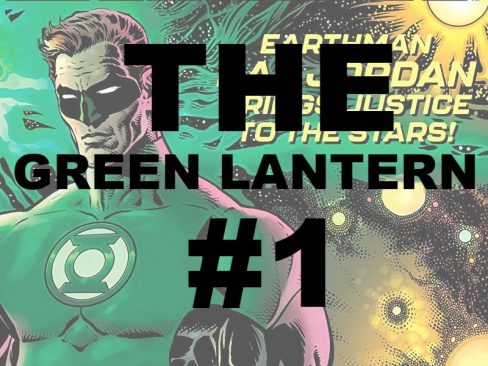
For most of us, the first comic we ever pick up is a single issue. In those 20(ish) pages, there can be so much (or so little) to hook us forever. What were the single issues this year that stood out among the rest? Keep reading.
5. Royal City #14

I’ll be honest here, I did not expect to get a chance to write about “Royal City” in our end of year retrospectives. It’s not that we here at Multiversity don’t love what Jeff Lemire puts out, this is just the kind of book that flies under the radar of most readers. It’s slice of life and isn’t exactly what you’d call action packed compared to something like Lemire’s smash hit “Black Hammer.” However, this is the Lemire I know and like the best. This is quiet and reserved with an emotional core that feels extremely personal to anyone from a complicated family.
“Royal City” #14 is the finale of the series as a whole and endings are probably the most important part of a story. Endings are what we remember. Endings tend to stay with us longer and “Royal City” #14 stays with you long after you finish the last page. The factory comes down and the Pike family learns to begin healing from all the trauma Tommy’s death left them with all those years ago. As they each emerge from the imagined version of Tommy they clung to, they all come out with hope and wisdom and begin to forge new beginnings for themselves. In this finale, Lemire gives a beginning, which isn’t as easy as it sounds. “Royal City” could have gone on far longer than it did – there was enough drama here to sustain the series for years. Lemire though pulls the plug and gives us and the Pikes closure on what happened to Tommy and leaves things on a happy yet poignant note.
Lemire tells us to let go of the past and create these new futures for ourselves and he does this in a very direct way through the narration and the art. The last couple of pages with the versions of Tommy all walking off together is extremely direct but it’s not bad in this case. It’s emotional and it resonated with me. The direct visual of letting go did a ton for closing the book on this chapter of the Pike family. “Royal City” #14 is a single issue that will stay with you for a long time and it’s the right note for this series to end on. It’s one of the very few single issues that stayed with me this year as a singular entity. – Jess Camacho
4. Peter Parker: The Spectacular Spider-Man #310 (tie)

Written and illustrated by Chip Zdarsky, “Peter Parker: the Spectacular Spider-Man” #310 marked the end of Zdarsky’s run on the title. It’s a simple story, focusing not on Spider-Man, but on how he has affected others. Presented through the lens of, well, a camera, Zdarsky takes us on a journey through the experiences of the everyday people that run into, are saved by, have lunch bought from, and/or have their days ruined, usually accidentally, by Spider-Man.
It’s a touching and sincere tribute to what the character means to us, resisting the urge to be maudlin and overly sentimental. Some of the interviewees offer glowing praise, some indifference, some offer angry anecdotes but all speak from the heart and all feel like stories you’d hear from your neighbor, your friend, or your cab driver. They make you laugh, they make you smile, and on rare occasions, they make you cry. Oh boy, will you cry.
Peter Parker is one of those characters who absorbs great amounts of tragedy, both big and small, played for laughs and for tears; understanding that part of his life is what make Zdarsky take on the character so powerful. In “Howard the Duck,” Spider-Man’s constant grieving and loss is the butt of many jokes (see Aunt May goes with Howard & Spidey thinks she’s been kidnapped.) In “Peter Parker: the Spectacular Spider-Man,” this character trait, his deep desire to help, and empathy for, those around him, is mined for all its earnesty.
Continued belowIt’s a powerful scene that is best experienced through reading. You don’t even need to read the rest of the run. This scene alone could have put issue #310 onto the list but it is the seamlessness with which the tones shift and meld that raises it above just another great Spider-Man tale. – Elias Rosner
4. The Immortal Hulk #3

The third issue of writer Al Ewing and penciler Joe Bennett’s “The Immortal Hulk” is a testament to comic books as an art form. I know that sounds hyperbolic, but hear me out.
I’m not going to retread on my colleague’s initial review, because it’s really good and you should read it, so just know “Immortal Hulk” #3 continues the episodic-horror approach and follows Jackie Mcgee as she interviews four separate people about a reported sighting of the ol’ Jade Giant, Each of the four different retellings of the same events are handled by a different artist- hence the issue title, ‘Point of View.’ That’s it.
It’s a simple trick that has a kind of profound effect on the issue and demonstrates the power of the comic artist. For example, “The Priest’s Story,” illustrated by Garry Brown, is the darkest and most hopeless version of the events. As such, Brown’s art is sketchy and full of heavy black space. Alternatively, Marguerite Sauvage’s “The Old Lady’s Story” is lighthearted and goofy (the old woman thinks Hotshot looks like James Dean) so her art is bright and completely unsegmented. Leonardo Romero’s “The Cop’s Story” is a Silver-Age jaunt and Paul Hornschemeier’s “The Bartender’s Story” is a surreal Clowes-esqe slice-of-life encounter between the bartender and a bum (a.k.a. Bruce Banner). Each vignette blends into the others until the picture is made whole. A goofy but terrifying picture of a hero. Which is exactly what The Hulk is: goofy, terrifying, heroic, and, maybe most importantly, a really unlucky guy who, despite being an honored Avenger, isn’t let in to use the dive bar’s bathroom.
Ewing tweaks his dialogue to better fit each story and its artistic tone, which is nice, but what that really does is prove the importance of the artist in comics. I know I don’t have to defend comics to our readers, but to the rest of the world, this issue is a defense of its own medium- and in defense of artists as storytellers.
Also, that Alex Ross cover is incredible. – Brandon Arnold
3. Amazing Spider-Man #801

“Amazing Spider-Man” #801 could’ve easily been a back-up in #800 – which by itself was a thrilling conclusion to Dan Slott’s decade long yarn – but he decided to present this one single story, ‘There For You,’ as his single final Spider-Man story, and it was all the more better for it.
Illustrated by Marcos Martin, who gave us Slott’s previous greatest Spider-Man story, ‘No One Dies,’ ‘There For You’ opens three weeks after the death of Uncle Ben, and introduces us to Kenneth Kincaid, Jr., an overworked office worker who is saved by Spider-Man during an armed robbery. Ah, an untold tale you reckon, perfect for Martin, the only living artist today who can truly emulate Steve Ditko’s original artwork.
But with a magical page following Kincaid over the next decade – the time span of Peter Parker’s career to date and Slott’s run – we’re back in the present, or sometime during the writer’s tenure, when Spidey is battling Mister Negative’s demons, and Kincaid is there to help return the favor. As Ol’ Webhead swings away, Kincaid’s niece bemoans that they didn’t bump into a cooler superhero like Thor, Captain Marvel or Black Panther, who go around saving the world. But as Uncle Ken (yep) explains in a beautifully rendered passage:
He saves a world every single day. Every person out there means the world to somebody. And Spidey’s out there risking his neck for all of ’em. Their best friends. Their husbands. Their moms. Their girlfriends. Their uncles.
That sound you hear is a lump in your throat as you’re reminded why Spider-Man is Marvel’s most beloved hero: because he’ll go overboard to protect everyone, not just save them. This one issue is a succinct depiction of the Talmudic phrase “whoever saves a single life is considered by Scripture to have saved the whole world.” And in a year that saw Spider-Man’s Jewish creators both pass away, there was no better tribute to them than that. – Christopher Chiu-Tabet
Continued below2. The Green Lantern #1

In a time when things get rebooted for no real reason and creators come and go off of superhero comics all the time, it is rare that a first issue can make such a thundering statement. But when Grant Morrison and Liam Sharp stepped into “The Green Lantern,” everything felt different. From the slightly different title to the ‘space cops’ back to basic approach, this couldn’t have felt more different than DC’s two recently wrapped Lantern series, even though one of them shared a lead character with “The Green Lantern.”
Sharp and Morrison embraced the chaos of the cosmos, creating worlds and creatures in this first issue that are far more interesting than what other, lesser creators have done in the Lantern books over the past few years. Sharp’s artwork was a revelation, and continues to speak to his re-emergence as one of the best at what he does.
But Morrison was the star here, crafting a perfect introduction to a new series that keeps everything close to the vest but also suggests dozens of stories that could spring forth from this world. If I sound hyperbolic, I apologize, but there hasn’t been a panel for panel superhero comic this good in a very, very long time. – Brian Salvatore
1. Saga #54

Super-mega-ultra-SPOILERS for “Saga” ahead. You have been warned.
I hate “Saga.”
We all knew what happened in “Saga” #54 was going to happen eventually. As soon as it became apparent that BKV and Fiona Staples had no problems with killing their darlings, I think every Saga reader has known that Marko and/or Alana were marked for death from the get-go. But doing the deed the issue after killing another fan-favorite character? At the hands of another beloved character? And then they have the gall to put the book on hiatus? Come on, now.
I love “Saga.”
It’s easy to be cynical about character death, especially in the age of Game of Thrones (which, as we all know, invented the idea of killing off your apparent main character). I was only being slightly tongue-in-cheek in the previous paragraph; to say that the death at the end of “Saga” #54 was a surprise would probably be a bit of a stretch for most fans. But in the moment, whether or not it is a “surprise” or a “twist” or a whatever-the-hell-you-want-to-call-it doesn’t matter. What matters is whether it feels meaningful, rather than cheap. Brian K. Vaughan give Marko’s death meaning, not necessarily in a superficial sense, like he accomplished something super important to the plot in risking his life, but in the sense that it serves as a logical end to his arc. Throughout the story, Marko has been a character defined by violence – largely the avoidance of it, with the occasional lapse. It only makes sense for violence to be the reason for his departure.
Vaughan is well-known for his dialogue, but he also has the important understanding every comic writer needs of when to step out of the way. And that’s part of what made this issue so fantastic. A good chunk of the pages of this issue have little to no dialogue, and instead consist of Fiona Staples doing what she does best: delivering some damn good storytelling. Staples gave the fight between Marko and The Will a nail-biting intensity, and despite the many fantastic things that occur within the ongoing’s pages this fight scene had minimal flash: just (alien) man versus (human-looking but maybe also alien?) man with a touch of magic and a heap of raw brutality. Marko versus The Will is one of the finest action scenes in a comic this year, and that’s without anything wild or out of the ordinary happening – it’s just an example of fine-tuned sequential art.
At this point it’s a Multiversity Comics Year in Review cliché to say it, but “Saga” is so consistently good that it’s easy to forget that it remains one of the best books on the shelves. #54 is a stunning reminder for those of us who forgot. Guys, take all the time you need if it will mean more issues like this one. – Walter Richardson
Continued belowEditors’ Notes:
Brian: I must admit, though guilty of it myself, I am a little bummed that our staff, save for one issue, picked all beginnings and endings. I understand the impulse, because it is far easier to isolate an issue from the beginning or end of something than it is to pluck from the middle of a run. That said, I’m really pleased to see some “Royal City” love, and despite all the praise we already heap on it, there’s no such thing as giving too much praise to “Saga.”
Matt: I think it’s funny how the selections are superhero books bookended by Image series. I also agree that “Royal City” and “Saga” are just consistently noice.






